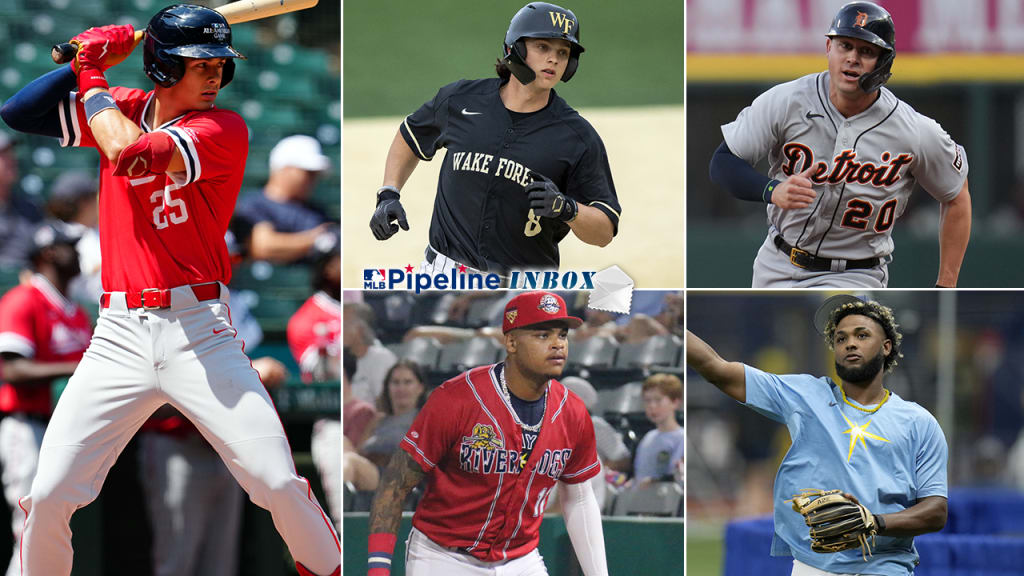
We kicked off our 2024 Draft coverage this week with a Top 100 list, an overview of the class and a way-too-early first-round projection. So let's keep it rolling with some Draft questions in the Pipeline Inbox ...
What's the comparison between Nick Kurtz and Spencer Torkelson when Torkelson was drafted? -- @StevieDAles97
Torkelson went No. 1 overall in the 2020 Draft out of Arizona State, while Kurtz could do the same in 2024 out of Wake Forest. Their profiles at the same stages of their careers were remarkably similar.
Both Torkelson and Kurtz were the best power hitters in their Draft class, and they also earned plus grades for their bats and demonstrated advanced control of the strike zone. They were both below-average runners with average arm strength. Though there was some talk that Torkelson might be able to play an adequate third base, they both projected as first basemen and the biggest difference was that Kurtz was a grade better defender (plus versus average).
As much as Kurtz gets touted, it pales in comparison to how scouts talked about Torkelson in 2020. He was considered the best offensive package to come out of the college ranks since at least Mark Teixeira two decades earlier. I did a story comparing the top two prospects in the pandemic Draft, Torkelson and Austin Martin, and it was full of quotes like this:
"Torkelson is as Major League-ready as any player I've ever seen in my entire life with his bat. If you want to take him and put him in the Major Leagues right away like Bob Horner, you could."
I don't see much difference between Torkelson and Kurtz, and the latter has the added advantage of batting left-handed. But Torkelson got a ton more hype.
The mock draft is intriguing. When was the last time that a HS kid wasn’t picked in the top 5 or 6 overall? Do historical trends in that area lean more toward a HS kid probably getting selected early again even though there aren’t any in your mock that high? -- @DraftPrep
My initial first-round projection began with eight straight college selections, something that never has happened before in Draft history. The longest a Draft went without a prep pick was in 2006, when the Dodgers took Clayton Kershaw at No. 7. The 1985 Draft was the most slanted at the top with colleges producing 11 of the first 12 choices.
Odds are that a high schooler, most likely outfielders Konnor Griffin or P.J. Morlando, will crack the top eight when teams actually make their picks in July. But the prep class as a whole is down this year, and the crop of college hitters is especially strong.
Factor in the ever-present demand for imminent pitching help as well, and collegians should dominate the first round of the 2024 Draft. Nineteen of the 22 selections and 24 of the 30 first-rounders in my projection came from the college ranks.
When was the last time 1 state's 2 teams had the 1st and 2nd picks in the draft? -- @NagyGypsy
The Guardians and Reds shockingly finished 1-2 in the Draft Lottery at the Winter Meetings despite 5,000-to-1 odds against that happening. Cleveland jumped from No. 9 to No. 1 and Cincinnati moved from No. 13 to No. 2, giving the state of Ohio the first two selections.
A same-state parlay happened at the top just three times in the first 58 Drafts. The first two involved the same California clubs, with the Angels taking Danny Goodwin and the Padres selecting Mike Lentz in 1975, and then Los Angeles choosing Darin Erstad and San Diego popping Ben Davis in 1995. Goodwin was the only player to go No. 1 overall in two different Drafts but didn't have much of a big league career.
In 1999, two Florida teams kicked off the Draft with the Devil Rays getting Josh Hamilton and the Marlins snagging Josh Beckett. Weighing the success of both players equally, that's probably the third-best 1-2 combo in Draft history behind B.J. Surhoff and Will Clark (1985) and Justin Upton and Alex Gordon (2005).
Between Xavier Isaac and Junior Caminero, who has more "raw power" and who has more "in-game power?" -- @jakelarsen
I love this question because it's an important distinction. The prospect wasteland is littered with guys who could crush the ball in batting practice but couldn't make enough contact to get to their power once games started. Usable pop matters more than raw pop.
Isaac, a surprise first-round pick by the Rays out of a North Carolina high school in 2022, has huge raw power. He's a massive 6-foot-4, 240-pound first baseman with prodigious strength and bat speed from the left side of the plate. The good news is that he has a sound approach as well, which helped him bat .285/.395/.521 with 19 homers in 102 games between two Class A levels at age 19.
Caminero is one of the best offensive prospects in baseball, reaching Tampa Bay last September after hitting .308/.373/.548 with 31 homers in 117 games between High-A and Double-A in his age-19 season. Stolen from the Guardians in a November 2021 trade for Tobias Myers, the third baseman has more bat speed but less strength than Issac, who outweighs him by 50 pounds.
Isaac has slightly more raw power but Caminero is a more advanced hitter and owns more game power. Both of them are potential 30-homer guys for the Rays, so it's close.
Jim Callis is a reporter for MLB.com. Follow him @jimcallisMLB and @jimcallis.bsky.social. Listen to him on the weekly MLB Pipeline Podcast.






